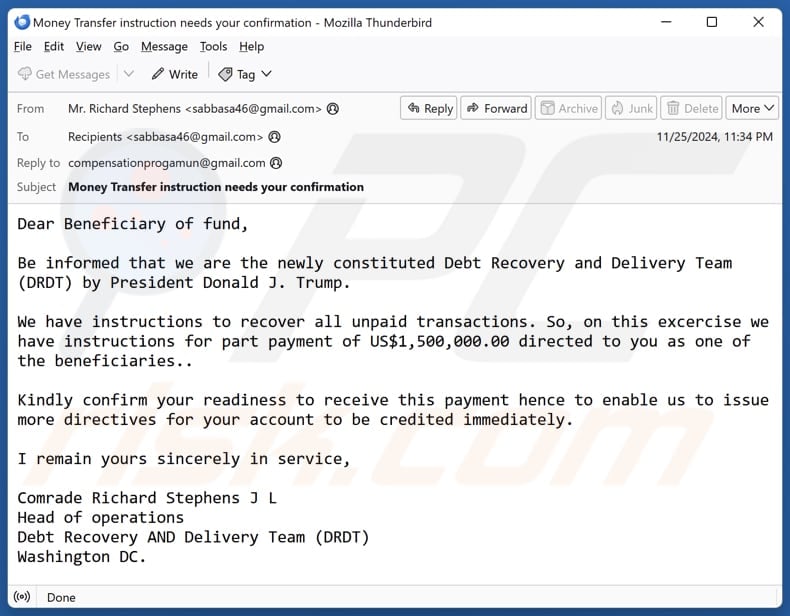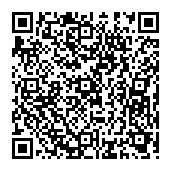How to spot scam emails like "Debt Recovery And Delivery Team (DRDT)"
![]() Written by Tomas Meskauskas on
Written by Tomas Meskauskas on
What is "Debt Recovery And Delivery Team (DRDT)"?
Our team has inspected the email and discovered that it is a fraudulent message claiming that the recipient can receive a large sum of money. Typically, scammers behind such emails seek to extract personal information from recipients or steal money from them. Either way, these emails should be ignored to avoid potential issues.

More about the "Debt Recovery And Delivery Team (DRDT)" scam email
This scam email pretends to be from a Debt Recovery and Delivery Team claiming to be appointed by Donald J. Trump. It states that the recipient is a beneficiary of a large sum of money (US$1,500,000.00) and requests confirmation to receive the payment. The email aims to trick the recipient into revealing personal information or sending money.
Scammers may ask for personal details like your name, address, date of birth, banking information, ID card details, and login credentials. They could also request payment details, including credit card numbers or advance fees via wire transfer, gift cards, or cryptocurrency.
Even if the request seems legitimate, it is important to be skeptical. If you receive unsolicited requests for sensitive data, it could be a scam. Always verify the legitimacy of the request before responding, and never provide financial or other information unless you are absolutely certain it is a trustworthy source.
| Name | Debt Recovery And Delivery Team (DRDT) Email Scam |
| Threat Type | Phishing, Scam, Social Engineering, Fraud |
| Fake Claim | Money transfer instruction needs your confirmation |
| Disguise | Letter from Head of Operations of Debt Recovery and Delivery Team (DRDT) |
| Symptoms | Generic greeting, urgent language, suspicious links, grammatical errors. |
| Distribution methods | Deceptive emails, rogue online pop-up ads, search engine poisoning techniques, misspelled domains. |
| Damage | Loss of sensitive private information, monetary loss, identity theft. |
| Malware Removal (Windows) | To eliminate possible malware infections, scan your computer with legitimate antivirus software. Our security researchers recommend using Combo Cleaner. |
Similar scam emails in general
Emails of this type often claim to be from trusted organizations or or other entities. They often mention large sums of money or urgent situations, like recovery of funds or prize winnings, to pressure recipients into acting quickly. Additionally, these emails ask for personal information, banking details, or payment to process the supposed transaction or reward.
Similar scams are "World Covid-19 Support Program (W.C.S.P)", "Elon Musk - Donation From Change", and "World Bank Group - Overdue Payment".
How do spam campaigns infect computers?
Cybercriminals use malicious attachments or links to trick users into infecting computers via email. If users open malicious executables, their computers can be infected right away. Other files, like infected Microsoft Office documents, might need the user to enable features like macros or perform other actions to execute malware.
When emails include malicious links, clicking them can lead to web pages that either trick users into downloading harmful software or automatically start downloading malware onto their devices. In most cases, the malware does not run unless users take some kind of action.
How to avoid installation of malware?
Always review emails (especially suspicious ones) carefully before taking any actions, such as opening attachments and links or replying. Avoid clicking pop-ups, ads, and links on questionable pages, and do not allow such sites to send you notifications. Regularly update the operating system and installed programs.
Download software from reputable sources, such as official websites or app stores. Use a reputable security tool and run system scans regularly. If you have already opened malicious attachments, we recommend running a scan with Combo Cleaner Antivirus for Windows to automatically eliminate infiltrated malware.
Text presented in the "Debt Recovery And Delivery Team (DRDT)" email letter:
Subject: Money Transfer instruction needs your confirmation
Dear Beneficiary of fund,
Be informed that we are the newly constituted Debt Recovery and Delivery Team (DRDT) by President Donald J. Trump.
We have instructions to recover all unpaid transactions. So, on this excercise we have instructions for part payment of US$1,500,000.00 directed to you as one of the beneficiaries..
Kindly confirm your readiness to receive this payment hence to enable us to issue more directives for your account to be credited immediately.
I remain yours sincerely in service,
Comrade Richard Stephens J L
Head of operations
Debt Recovery AND Delivery Team (DRDT)
Washington DC.
Instant automatic malware removal:
Manual threat removal might be a lengthy and complicated process that requires advanced IT skills. Combo Cleaner is a professional automatic malware removal tool that is recommended to get rid of malware. Download it by clicking the button below:
▼ DOWNLOAD Combo Cleaner
By downloading any software listed on this website you agree to our Privacy Policy and Terms of Use. To use full-featured product, you have to purchase a license for Combo Cleaner. 7 days free trial available. Combo Cleaner is owned and operated by Rcs Lt, the parent company of PCRisk.com read more.
Quick menu:
- What is Debt Recovery And Delivery Team (DRDT) phishing email?
- Types of malicious emails.
- How to spot a malicious email?
- What to do if you fell for an email scam?
Types of malicious emails:
![]() Phishing Emails
Phishing Emails
Most commonly, cybercriminals use deceptive emails to trick Internet users into giving away their sensitive private information, for example, login information for various online services, email accounts, or online banking information.
Such attacks are called phishing. In a phishing attack, cybercriminals usually send an email message with some popular service logo (for example, Microsoft, DHL, Amazon, Netflix), create urgency (wrong shipping address, expired password, etc.), and place a link which they hope their potential victims will click on.
After clicking the link presented in such email message, victims are redirected to a fake website that looks identical or extremely similar to the original one. Victims are then asked to enter their password, credit card details, or some other information that gets stolen by cybercriminals.
![]() Emails with Malicious Attachments
Emails with Malicious Attachments
Another popular attack vector is email spam with malicious attachments that infect users' computers with malware. Malicious attachments usually carry trojans that are capable of stealing passwords, banking information, and other sensitive information.
In such attacks, cybercriminals' main goal is to trick their potential victims into opening an infected email attachment. To achieve this goal, email messages usually talk about recently received invoices, faxes, or voice messages.
If a potential victim falls for the lure and opens the attachment, their computers get infected, and cybercriminals can collect a lot of sensitive information.
While it's a more complicated method to steal personal information (spam filters and antivirus programs usually detect such attempts), if successful, cybercriminals can get a much wider array of data and can collect information for a long period of time.
![]() Sextortion Emails
Sextortion Emails
This is a type of phishing. In this case, users receive an email claiming that a cybercriminal could access the webcam of the potential victim and has a video recording of one's masturbation.
To get rid of the video, victims are asked to pay a ransom (usually using Bitcoin or another cryptocurrency). Nevertheless, all of these claims are false - users who receive such emails should ignore and delete them.
How to spot a malicious email?
While cyber criminals try to make their lure emails look trustworthy, here are some things that you should look for when trying to spot a phishing email:
- Check the sender's ("from") email address: Hover your mouse over the "from" address and check if it's legitimate. For example, if you received an email from Microsoft, be sure to check if the email address is @microsoft.com and not something suspicious like @m1crosoft.com, @microsfot.com, @account-security-noreply.com, etc.
- Check for generic greetings: If the greeting in the email is "Dear user", "Dear @youremail.com", "Dear valued customer", this should raise suspiciousness. Most commonly, companies call you by your name. Lack of this information could signal a phishing attempt.
- Check the links in the email: Hover your mouse over the link presented in the email, if the link that appears seems suspicious, don't click it. For example, if you received an email from Microsoft and the link in the email shows that it will go to firebasestorage.googleapis.com/v0... you shouldn't trust it. It's best not to click any links in the emails but to visit the company website that sent you the email in the first place.
- Don't blindly trust email attachments: Most commonly, legitimate companies will ask you to log in to their website and to view any documents there; if you received an email with an attachment, it's a good idea to scan it with an antivirus application. Infected email attachments are a common attack vector used by cybercriminals.
To minimise the risk of opening phishing and malicious emails we recommend using Combo Cleaner Antivirus for Windows.
Example of a spam email:

What to do if you fell for an email scam?
- If you clicked on a link in a phishing email and entered your password - be sure to change your password as soon as possible. Usually, cybercriminals collect stolen credentials and then sell them to other groups that use them for malicious purposes. If you change your password in a timely manner, there's a chance that criminals won't have enough time to do any damage.
- If you entered your credit card information - contact your bank as soon as possible and explain the situation. There's a good chance that you will need to cancel your compromised credit card and get a new one.
- If you see any signs of identity theft - you should immediately contact the Federal Trade Commission. This institution will collect information about your situation and create a personal recovery plan.
- If you opened a malicious attachment - your computer is probably infected, you should scan it with a reputable antivirus application. For this purpose, we recommend using Combo Cleaner Antivirus for Windows.
- Help other Internet users - report phishing emails to Anti-Phishing Working Group, FBI’s Internet Crime Complaint Center, National Fraud Information Center and U.S. Department of Justice.
Frequently Asked Questions (FAQ)
Why did I receive this email?
Scammers often send such emails to a large number of people, relying on the likelihood that a few recipients will fall for the scheme. These emails are sent randomly and not specifically targeted.
I have provided my personal information when tricked by this email, what should I do?
If you have shared personal information like login credentials on a phishing website, promptly update the passwords for any accounts that could be impacted. In other cases (if you have shared other personal details), contact the relevant authorities.
I have downloaded and opened a malicious file attached to an email, is my computer infected?
If the file is an executable, your system is at a high risk of infection. However, if it is a document file (such as a .pdf or .doc), the risk is lower, as simply opening these files typically does not result in malware infection unless further actions are performed.
I have read the email but did not open the attachment, is my computer infected?
Opening an email is generally safe, but clicking on links or opening attachments in fraudulent emails can put your system at risk of infection.
Will Combo Cleaner remove malware infections that were present in email attachment?
Combo Cleaner is effective at detecting and removing most known malware infections. However, advanced malware often conceals itself deep within the system, making a full system scan essential for thorough protection.


▼ Show Discussion